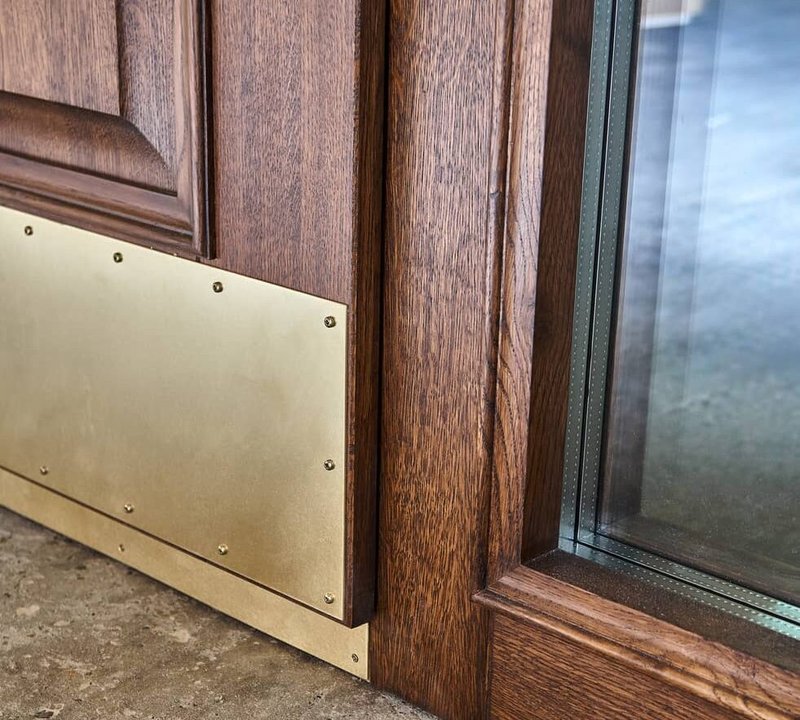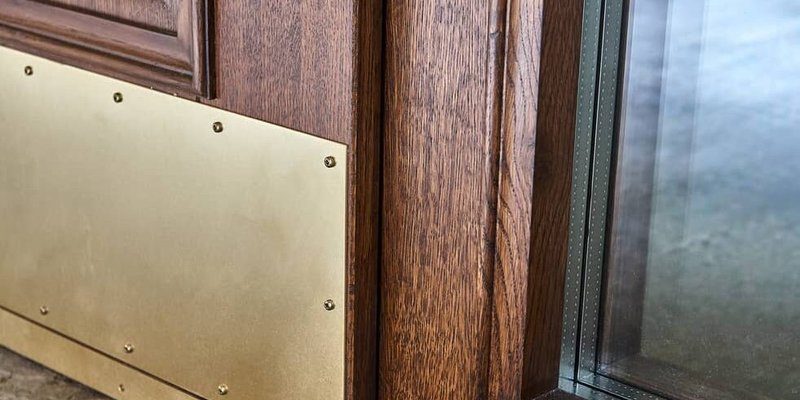
Let me explain: whether you’ve got a classic Schlage brass kick plate on your front door or a generic stainless steel one in the mudroom, a kick plate that’s not flat can happen for all sorts of everyday reasons. Sometimes, installs go sideways. Other times, the house just settles, humidity spikes, or you swap out a battery in a smart lock and the plate gets bumped. Honestly, most folks only notice the problem when dirt collects, shoes get caught, or the door won’t close right. But don’t stress. Hands-on troubleshooting is easier than you’d think—no pro required.
What Causes a Kick Plate to Bow or Stick Out?
If your kick plate isn’t lying flat, there’s probably a straightforward reason behind it. The most common culprit is warping—either the door itself has changed shape over time, or the kick plate has bent from repeated kicks and bumps. Think about it: each time you nudge the door open with your foot, you’re giving that metal plate a tiny nudge, too.
Another big factor is installation. Sometimes, installers rush or use the wrong screws. Maybe the screw heads are too big, or the holes weren’t drilled deep enough. Even a brand-brand new Kwikset or Yale kick plate can have this issue if it wasn’t put on just right. If the plate wasn’t centered or pressed tightly during install, tiny gaps will eventually show up.
Let’s not forget about weather and moisture. When seasons change, wood expands and contracts, causing the door to slightly shift. A metal kick plate can’t flex the same way, so it starts to pop away from the surface, especially at the corners. And if you have pets or kids, constant tapping or scratching can loosen the plate over time. It’s all normal wear and tear, but it’s fixable.
Spotting the Real Issue: Warped Plate or Door?
You might be wondering if the kick plate is the real problem, or if the door itself is the culprit. Here’s the thing: not all kick plates are created equal, and doors can be surprisingly stubborn.
Run your hand along the plate. If it feels bowed out in the middle, odds are the plate is warped. If it lifts at the edges but the center sits tight, that usually points to installation issues or door warping. Lightly press on different sections. Does it flex, or does it feel permanently bent? Sometimes, you’ll actually see a small gap or feel the plate clatter when you tap it.
Another trick: open the door and look from the side. Is the plate flush along the length, or do you see daylight at one or both ends? If the door is warped—maybe swollen from a rainy month—the entire bottom edge might look wavy. But if the door is flat and the plate is the only thing sticking out, you might just need to reset or replace the plate.
Essential Tools and Parts for Fixing a Kick Plate
Before jumping into repairs, it’s smart to gather a few simple tools. You don’t need anything fancy—just the basics. Trust me, you don’t want to run back and forth to the garage once you get started.
- Screwdriver (Phillips or flathead): Most kick plates use simple screws, but double-check the heads before you start.
- Replacement screws: If the old ones are stripped or rusty, new ones make a difference. Stainless steel is best for outdoor doors.
- Level: To make sure the plate sits straight. A pocket-sized one is fine.
- Wood glue or adhesive: Optional, but helpful for stubborn edges or for supplementing old screw holes.
- Drill (with bits): For making new holes if the old ones are worn out or too loose.
- Clamps: If you need to hold the plate tight while adhesive sets.
Sometimes, a warped kick plate can be bent back into shape with gentle pressure—or by sandwiching it between flat boards and weighting it overnight. If you see serious creases, though, replacement is usually quicker and cleaner. Pro tip: If you need a new plate, measure the door width first. Kick plates come in standard sizes, but it never hurts to double-check.
Step-by-Step: How to Fix a Kick Plate That’s Not Flat
Here’s where the rubber meets the road. Let’s walk through the process of troubleshooting and fixing a kick plate that won’t sit flat.
- Remove the kick plate: Unscrew each fastener, keeping track of the hardware. If screws are stuck, a gentle tap with the screwdriver handle can help.
- Inspect the plate and door: Lay the plate flat on a table to see if it wobbles or rocks. Check the door’s bottom edge for unevenness or swelling.
- Straighten or replace the kick plate: For mild bends, gently press the plate against a flat surface or use clamps overnight. For severe bends, swap it out for a new one.
- Prep the door surface: Wipe away dust, fill stripped holes with wood glue if needed, and let dry. If using adhesive, apply a thin line along the plate’s back edge.
- Reattach the kick plate: Hold it firmly against the door, making sure it’s centered. Screw it in evenly—don’t over-tighten, or you’ll warp the metal all over again. Check with a level for a straight fit.
If you want extra security, add a dab of clear adhesive along the corners before screwing it down. Give everything a final wipe so it looks good as new.
When You Need a New Kick Plate
Sometimes, a kick plate is simply past its prime. If you’ve tried all the bending and adjusting you can, but the metal keeps popping out or the finish is scuffed beyond recognition, it’s time for a fresh start.
Honestly, replacing a kick plate is easier than you’d think. Most big hardware stores carry standard sizes that fit the major brands—like Schlage, Kwikset, and Yale. Universal options are available too, with pre-drilled holes that line up with most screw patterns. The big decision is whether you want to match your door hardware for a polished, coordinated look.
Installation is just like the troubleshooting steps, but without the guesswork. Mark your screw locations, set the plate in place, and attach it with fresh hardware. If you’re switching brands or moving to a universal kick plate, you might need to drill new holes—but it’s a five-minute job with the right bit. Just remember to measure your door width first!
Quick Fixes vs. Long-Term Solutions
You might be tempted to try a quick fix—like double-sided tape, heavy-duty glue, or even wedging a shim behind the plate. Sometimes these tricks do the job, especially if you’re short on time. But here’s the thing: they rarely last through weather, foot traffic, or the next battery swap in your smart lock.
A proper re-install, with fresh screws and a level, is always your best bet for a flat, secure fit. If the problem keeps coming back, that’s a sign your door needs a closer look. In rare cases, a badly warped door or repeated moisture exposure means more than a kick plate is out of whack.
If you rent, patch jobs can be fine for now. For long-term peace of mind (and curb appeal), a full install is worth the effort.
Comparing Kick Plate Types and Brands
Not all kick plates are the same. Some are thin, stamped metal; others are heavy-duty brass or stainless steel. If you have a Schlage, Kwikset, or Yale kick plate, you’re dealing with trusted brands that use solid materials and smart mounting hardware. Universal kick plates can be great, too, but check the thickness. Thin aluminum can warp faster, especially in high-traffic areas.
You might see fancy options with decorative finishes (like oil-rubbed bronze or matte black). Those look sharp but may need gentler handling to keep scratches at bay. If your door is exposed to rain or salt (hello, porch steps!), choose a rust-resistant finish. For smart doors—with electronic locks—you may need to avoid certain adhesives that interfere with the battery compartment or sync codes.
A quick tip: if you’re getting frustrated and the plate just won’t sit flat no matter what, try a universal plate with adjustable screw holes. Sometimes, a different mounting pattern is all it takes to get the tight fit you want.
Keeping Your Kick Plate Flat: Simple Maintenance Tips
Once your kick plate is sitting pretty again, a little maintenance goes a long way. Wipe it down regularly to keep dirt from building up at the edges. Every few months, check the screws to make sure none have come loose. If you see rust or corrosion, swap out the fasteners for stainless steel.
For doors in humid areas, look for signs of swelling or paint chipping around the plate. That’s your cue to reseal the door bottom or adjust the fit before bigger problems start. If you have a smart door with keypad or Bluetooth hardware, make sure nothing is interfering with the battery housing or code sync points—especially if you’ve recently adjusted or reset accessories nearby.
A small investment of ten minutes every season can keep your door looking sharp and your kick plate perfectly flush for years.
Final Thoughts: A Flat Kick Plate Is a Simple Fix
A kick plate that sticks out might seem minor, but it’s one of those little details that can drive you up the wall once you notice it. The good news? With some basic tools and a bit of patience, you can troubleshoot and fix the problem in under an hour—no pro needed. Whether you’re dealing with a sturdy Schlage plate, a universal brand, or anything in between, keeping it flat means a cleaner, safer, and more handsome entryway.
Next time you spot that metal strip poking out, you’ll know exactly what to do. Give your door a quick inspection, grab your screwdriver, and tackle the job with confidence. Your future self—and your shoes—will thank you.
